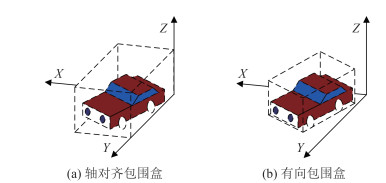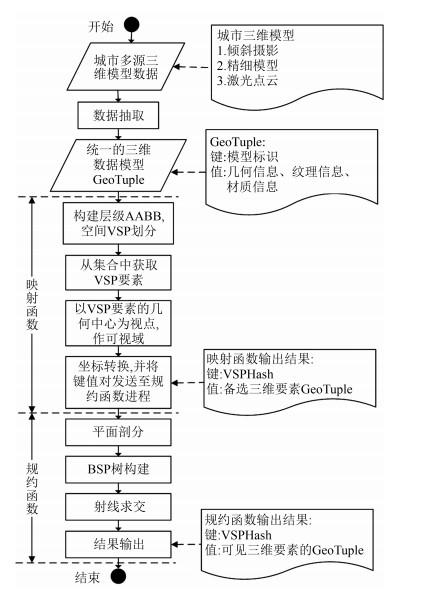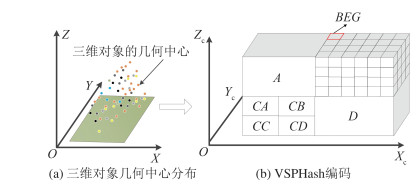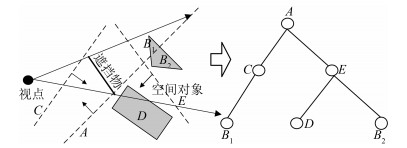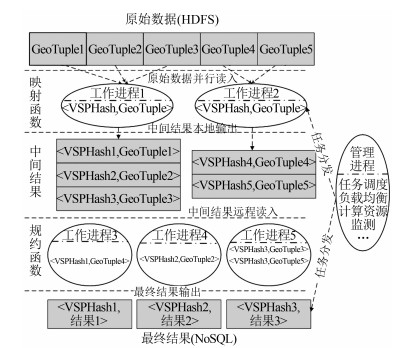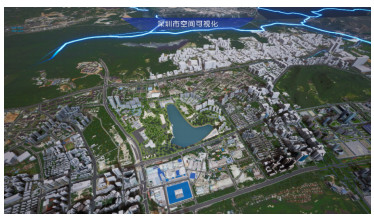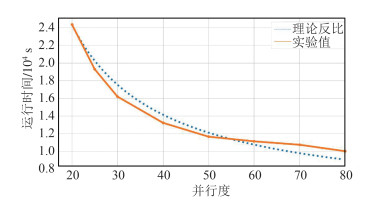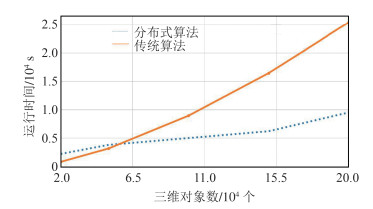Distributed Visible Query Method for Regional Objects Using Map‐Reduce
-
摘要:
区域对象的可视查询是沿着区域视线方向剔除三维空间数据中一些表面被遮挡住而导致不可见的数据,从而提高大规模三维场景的可视渲染效率。针对传统区域可视查询视点空间划分粒度细、计算难度大的现状,提出了一种基于映射‐归约的分布式可视查询方法。在映射函数中,按照三维对象的空间分布规律构建层级轴对齐包围盒,以轴对齐包围盒为视点空间划分区,将可视域范围内三维对象发送至规约函数中进行可视判断。在规约函数中,利用平面拆分后射线求交方法,通过构建二叉空间分割树计算每一视点空间划分区的潜在可视集,从而实现三维空间对象的分布式可视查询。将此方法用于深圳市20多万个三维空间对象的可视查询实验中,从数据量、划分粒度和并行度等角度验证了算法的可行性和有效性。
Abstract:ObjectivesIn the large-scale of virtual reality scene, it is difficult to add all graphics data into the video memory for rendering. Removing the occluded objects in advance by visible query technology can reduce the amount of data loaded on the display end to improve the rendering efficiency. Therefore, the research of visible query method for regional objects has important application value for real-time rendering of large-scale urban scene.
MethodsWe put forward a distributed visible query method based on Map-Reduce. In the map phase, we apply a hierarchical axis-aligned bounding box as viewpoint space partition. When the number of 3D objects in viewpoint space partition exceeds the threshold, the axis-aligned bounding box continues to be divided into sub- boxes. After the above process, the map tasks produce GeoTuples with the VSPID as key and visible query candidate set as value. In the reduce phase, a viewpoint is created for each leaf axis-aligned bounding box where the binary space partitioning trees are build and the visible set is calculated using real-time occlusion algorithm.
ResultsThe experiment results with a building compound, containing more than 200 000 geometric solids, in Shenzhen, China show that: (1) There is no simple linear relationship between the running time of distributed visible query and the number of viewpoint space partitions. (2) Running time and parallelism are not simply inversely proportional. The computational efficiency of each process first increases and then decreases with the increase of parallelism. About 48 parallelism, the process has the highest efficiency. (3) Whether the distributed approach is better than the traditional approach depends on the number of 3D objects. After the amount of 3D objects reaches about 40 000, the distributed algorithm begins to be better than the traditional algorithm.
ConclusionsThe computational experiments reveal the proposed algorithms outperform competitors in terms of the processing efficiency and feasibility, which can meet the requirement of visible query in large-scale scenarios.
-
2015-04-25T14:11:00(北京时间)尼泊尔Gorkha附近发生了Mw 7.8级强震。截止2015-05-28,尼泊尔及周边国家已有8 964人丧生,21 952人受伤,300余万人口无家可归[1]。该地震所触发的大量山体滑坡、雪崩等次生灾害已造成了严重的人员伤亡与经济损失[1-2]。
快速实现对震后山体滑坡、雪崩分布的监测对震后救灾和次生灾害的预防非常关键,遥感技术是滑坡等灾害监测的重要手段[3-6]。目前,高分辨率光学影像已被广泛应用于震后滑坡的监测研究中,主要采取目视解译方法[3]。该方法可以准确提取滑坡信息,为灾害救援工作提供详实的技术支持,已成功应用于多个地震案例[3-4],但需要判读者具备丰富的遥感影像判读经验。除了目视解译的方法,遥感领域也发展了基于多波段分类与差值等自动化判读方法[3, 6]。近年来发展起来的影像亚像素相关性匹配技术[7-9](sub-pixel correlation,SPC)已广泛应用于地震形变场的提取,如2003年Bam地震[10]、2005年Kashmir地震[11]和2013年的巴基斯坦地震[9, 12]等。该技术的研究主要侧重形变信息的获取,失相关信息一般只作为噪声进行掩膜清除。由于尼泊尔震区特殊的地质和地势特点,本次震害滑坡、雪崩造成震害滑坡分布广泛,形变场存在较大比例的失相关噪声。基于研究现状与震区实际情况,本文以Landsat 8影像为主,综合遥感影像目视解译与SPC技术探讨从形变场失相关信息中提取震害滑坡与雪崩沉积区域的流程方法。
1 数据处理与分析
1.1 影像数据
Landsat 8由美国国家航空航天局(NASA)在2013-02-11发射升空,全名为地球资源卫星数据连续性任务(Landsat Data Continuity Mission,LDCM)。与之前的系列卫星相比,Landsat 8的全色波段(Band 8)的空间分辨率更高(15 m),能更好地监测地表地物变化,在气象条件允许的情况下非常适合大范围形变监测[9, 12]。此外,Landsat 8影像具有丰富的多波谱信息,通过合成多波段影像,可凸显出相应的地表变化,有利于震害滑坡的识别。本文收集了覆盖地震区域的震前和震后的Landsat 8数据4对,轨道号为141、140;分幅号为40、41(如表 1和图 1所示)。由于震后影像普遍受云层影响严重,本文选择了含云量较少的震前影像,以保证震前、震后数据的相关性。USGS提供的Landsat 8数据是已经做过正射校正的L1T产品,校正精度可满足SPC技术要求。
表 1 本文实验所采用的Landsat 8影像信息Table 1. Information of Landsat 8 Images Used in This Study影像对 时段 轨道号 分幅号 获取时间 云量/% 影像对1 震前 141 41 2014-03-26 2.4 震后 141 41 2015-04-30 30.2 影像对2 震前 141 40 2014-01-05 4.4 震后 141 40 2015-04-30 30.2 影像对3 震前 140 41 2015-03-22 11.8 震后 140 41 2015-05-25 25.6 影像对4 震前 140 41 2014-03-19 17.4 震后 140 41 2015-05-22 13.1 如图 1所示,右上方小图浅蓝色方框为Landsat 8影像覆盖区域,红色方框为大图所显示的区域,下方大图中洋红色方框为本文所选取的吉隆、郎塘、聂拉木和珠峰4个实验区,红色五角星分别显示的是2015-04-26 Mw 6.7级余震与2015-05-12 Mw 7.3级余震的震中位置,绿色点表示地震一个月内的余震分布。
1.2 数据处理方法与流程
本文采用的SPC技术是基于窗口的影像纹理匹配,任何因素导致的纹理破坏、模糊、缺失都会造成匹配失败,进而产生失相关噪声。对该地震而言,本文将失相关噪声分为3类:一是时相失相关,例如云层、植被生长变化、人工设施拆建以及太阳角度变化在地形复杂区域所引起的地表辐射量变化等;二是辐射失相关,例如白雪、沙地、严重的地形阴影与大面积水域等辐射量过高或过低或为常数,造成匹配算法无法识别影像纹理;三是形变失相关,如震害滑坡、雪崩引起地表剧烈变化,造成影像纹理缺失或变化,进而无法匹配引入失相关噪声。根据相关研究[13-14],尼泊尔强震在震源中心附近造成2 m左右的水平同震形变。故本文假定,SPC技术获取的形变量绝对值小于等于2 m,认为是可靠测量值;否则认为是离群值。本文将离群值分为趋势性离群值与随机性离群值。趋势性离群值排除形变误差区域,可获取反映真实地表形变趋势的信息,可用于冰川形变提取;随机性离群值由SPC算法在匹配失败后对计算窗口的随机赋值得到,即失相关噪声,多对应低信噪比(signal noise ratio,SNR),本文从随机性离群值与低SNR中提取滑坡与雪崩沉积区域。利用震前、震后影像进行亚像素相关性匹配,提取震害滑坡体、雪崩沉积区域与雪崩区形变的具体流程如下。
1) 影像预处理。选取震前、震后覆盖相同区域的影像做几何校正,并圈定云、阴影区域,以分析形变场中的失相关区域。
2) 计算影像的偏移量。利用频域相关性算法对震前、震后的数据进行SPC计算,获取偏移量;窗口大小为32像素×32像素,步长为4像素,稳健迭代2次,频率掩膜阈值为0.9。
3) 后处理。经过相关性计算后的结果中包含着许多误差,利用一阶多项式去除形变图中轨道趋势误差,通过均值滤波进一步降低形变图中其他噪声水平。
4) 失相关区域。圈定同震形变场中的失相关区域,即低SNR与随机性离群值区域。
5) 形变失相关区域。本文将失相关区域减去已确定的噪声失相关区域,初步确定形变失相关区域,再利用多源遥感影像目视解译方法对这些区域进行验证,进一步确定震害滑坡与雪崩沉积区域。
6) 雪崩区形变。从同震形变场中的趋势性离群值中提取雪崩区形变场并进行分析。
2 滑坡体、雪崩沉积区提取与分析
本文选取中国的吉隆和聂拉木两个典型滑坡受灾区,以及尼泊尔受雪崩危害严重的郎塘,利用§1.2方法提取出实验区内震害山体滑坡与雪崩沉积区。另外统计滑坡中心点位置、高程、坡度、坡向和对应的滑坡面积等信息,以此来分析震害滑坡与地形因子之间的关联性。
2.1 滑坡识别与提取
吉隆是中尼边境的口岸城镇,位于尼泊尔强震中心的东北方向,距离约66 km。在本次强震与随后的余震中,该镇发生了严重的山体滑坡灾害。图 2中黑色矩形方框表示滑坡区域,椭圆圈出部分表示植被覆盖、人工建筑、阴影等因素导致的失相干噪声区域。图 2(c)中,黑色表示失相关区域。图 2(d)~2(g)分别对应图 2(c)相应绿色矩形方框的震前震后多波段(SWIR2/SWIR1/NIR)合成影像对比图,滑坡体在震后影像图中呈现亮色区域(白线圈出)。
通过分析低SNR与随机性离群值区域快速确定形变失相干,即山体滑坡区域,并通过高分影像目视解译的方法对以上结果进行验证。Landsat 8影像的空间分辨率15 m,实验获取的形变图空间分辨率为60 m×60 m,难以实现对小滑坡区域的监测,导致SPC技术无法监测出微小滑坡体。值得注意的是,震前震后影像的太阳高度角、方位角偏差也会造成趋势性离群值产生。此外,人工建筑设施的拆建、植被变化、云层覆盖等会造成时相失相关。这些误差的识别与去除也会一定程度影响本文方法提取滑坡体的精度。
利用目视解译方法在吉隆镇识别了21处滑坡体(见图 3)。其中J01为该区域的最大滑坡体,位于冲色村附近河谷,该滑坡堵塞河道造成上游堰塞湖的生成,专家分析结果[14]对该滑坡体进行了确认。失相关区域能够较好地涵盖该区域的大滑坡体(大于3 600 m2),涵盖率为85.7%。该技术对大滑坡体的监测涵盖率未达到100%,主要是因为一部分滑坡体呈线状分布,直径幅宽低于本文设计的测量精度60 m,无法识别。除此之外,本文设定的窗口可能过大,漏检了部分滑坡区域。表 2列出了该区域21个滑坡体的参数与地形信息。
表 2 吉隆山体滑坡编目表Table 2. Landslides Catalog of Jilong序号 滑坡位置 滑坡体面积/m2 技术监测手段 高程/m 坡向/(°) 坡度/(°) 东经/(°) 北纬/(°) SPC 目视判读 J01 85.363 28.360 163 646 √ √ 2 615 289.6 52.8 J02 85.359 28.354 29 052 √ √ 2 370 268.7 43.5 J03 85.337 28.376 37 580 √ √ 2 490 80.4 30.2 J04 85.324 28.389 49 045 √ √ 2 737 312.1 45.9 J05 85.305 28.401 5 599 √ √ 2 837 359.1 37.3 J06 85.304 28.406 33 891 √ √ 2 809 28.9 40.3 J07 85.350 28.364 2 603 √ √ 2 543 10.6 47.5 J08 85.345 28.369 11 552 √ √ 2 415 165.9 38.9 J09 85.337 28.374 5 967 √ √ 2 450 102.1 33.3 J10 85.340 28.381 7 431 线状滑坡× √ 2 839 208.5 53.9 J11 85.337 28.374 1 295 小滑坡× √ 2 603 24.7 27.1 J12 85.355 28.364 680 小滑坡× √ 2 472 120.0 45.7 J13 85.370 28.376 6 789 √ √ 2 925 212.4 44.8 J14 85.358 28.370 42 480 √ √ 2 439 196.8 52.6 J15 85.355 28.372 1 057 小滑坡× √ 2 550 172.0 41.4 J16 85.308 28.404 2 263 小滑坡× √ 2 804 191.8 33.3 J17 85.303 28.408 1 728 小滑坡× √ 2 805 49.1 42.9 J18 85.312 28.399 3 628 小滑坡× √ 2 741 172.1 25.6 J19 85.358 28.411 351 小滑坡× √ 2 984 135.1 37.0 J20 85.364 28.382 21 275 √ √ 3 152 256.7 48.2 J21 85.365 28.382 17 310 √ √ 3 152 256.7 42.7 注:√表示可以监测到对应滑坡体,×表示无法监测到对应滑坡体。 聂拉木区域大部分滑坡体在影像中被云层覆盖,形变失相关区域不够明显,为增加参与后面滑坡因子分析的数据量,本文只采用高分辨率影像目视解译方法获取该区域的10处山体滑坡(如图 4和表 3所示)。
表 3 聂拉木山体滑坡编目表Table 3. Landslides Catalog of Nyalam序号 滑坡位置 滑坡体面积/m2 高程/m 坡向/(°) 坡度/(°) 东经/(°) 北纬/(°) N01 85.997 28.090 46 565 3 457 123.3 37.6 N02 85.998 28.087 7 153 3 264 177.7 31.7 N03 85.990 28.084 13 099 3 769 166.3 60.8 N04 85.997 28.085 6 360 3 238 270 26.9 N05 85.991 28.046 38 639 3 265 274.9 57.1 N06 85.994 28.039 53 518 3 049 171.8 32.8 N07 85.981 28.032 51 028 3 157 100.9 68.8 N08 85.980 28.021 12 191 2 602 106.2 45.4 N09 85.963 27.983 309 600 2 375 157.2 60.8 N10 86.039 27.975 381 165 3 462 106.5 42.2 2.2 滑坡分布统计分析
本文对吉隆与聂拉木滑坡体数目、滑坡面积、滑坡平均面积(共31处)与地形坡度的关系做简单的统计分析,结果如图 5所示。即每5°作为一个区间范围,通过计算范围内的滑坡个数与滑坡总个数的商,计算其所占百分比统计结果,同时统计区间范围内的滑坡总面积与平均面积。发现滑坡体分布呈现近似高斯正态分布,且主要分布在坡度大于30°(90%以上)的地形,坡度40°~ 45°为中型滑坡体(面积大于半个窗口)多发的坡度范围,且总体滑坡面积最大。同时发现单体(平均)滑坡面积随坡度的增大呈上升趋势,这说明坡度越高越容易触发单体面积大的滑坡,这类震后滑坡危害更为严重,需要重点监测。此外,滑坡体多沿河谷两侧分布,与坡向无明显关系。汶川地震等案例中的震害滑坡分布也得出了类似的统计特性[3, 6]。
2.3 雪崩沉积区识别与提取
尼泊尔郎塘在此次地震中受灾严重[14-15], 该区域海拔高度在3 000 m以上,地势起伏很大,周边冰川广泛发育。与滑坡体不同,雪崩实际发育区域多为辐射亮度较高的冰雪区域,纹理特征变化不明显,难以识别。而雪崩碎屑沉积区多为海拔较低区域,当地的地面纹理特征一般会遭到严重破坏,因此用本文§2.1中滑坡体识别方法来识别雪崩沉积区域。
图 6(a)~6(c)中黑线圈出的A、B、C、D为排除云噪声后识别出的失相关区域。图 6(e)中红色虚线圈出部分为云噪声,白线圈出部分为目视解译出的雪崩碎屑物质覆盖区域, 分别对应6(a)、6(b)、6(c)中的A (Chyamki)、B (Langtang Village)、C (Mundu)、D (Singdum)所圈出的失相关区域,本文所获得的结论与Kargel等[14]通过0.5 m分辨率WorldView2目视解译的结果基本吻合。
3 雪崩区形变分析
随着全球气候变暖,冰川消退速度加快,解冻岩层与冰川融水等因素本身就削弱了局部地质的稳定性。这时如果再发生此类大型地震,引发雪崩滑坡灾害的机率与风险会更大。本文对珠峰附近20 km×20 km区域进行形变监测(表 1中的影像对3),其中昆布冰川5 300 m海拔高度冰瀑区发生大型雪崩,本文重点对其进行形变监测,同时分析了东绒布冰川的疑似雪崩区。如图 7所示,对应冰川区有较为明显的形变量。冰川运动一般由自身重力引起,但是地震导致的大范围雪崩会对冰川局部运动产生影响。本文分别对昆布冰川与东绒布冰川选取了E、F两个区域,提取并分析了E、F两个典型冰川的水平形变场。
图 8(a)中红色箭头表示E区域的冰川运动方向与大小,图 8(b)分别表示东西向与南北向形变,黑线圈定区域为昆布冰川的雪崩高发区。对应区域冰川运动了约22~77 m(平均运动39 m,时间基线64 d)。而Scherler等[16]研究表明昆布冰川相应区域的水平运动速率约为20~130 m/a,换算到对应的时间段约为3~21 m,很有可能是由地震触发的雪崩造成的。
图 9(a)对应图 7中的F实验区,图 9(b)显示图 9(a)中红色虚线方框区域的震前(2014-03-19-2014-05-22,64 d)、震后(2015-03-22-2015-05-25,64 d)近似时间间隔的东西向与南北向形变场。鉴于两个影像对成像时间基本一致,认为其误差水平相同,而相同区域在地震发生前表现为5~20 m的形变量,地震发生后表现为失相关,说明该区域地表发生了剧烈变化,本文将该区域圈定为疑似雪崩区域。
4 结语
震后滑坡灾害的识别与提取对地震触发滑坡机理的探讨和防灾减灾具有重要的理论意义和应用价值。本文从Landsat 8影像所获得形变场中的失相干噪声中提取震害滑坡体与雪崩沉积区。实验结果表明本文方法可行,结果可靠。同时滑坡体与地形因子的统计分析结果表明, 实验区内震后山体滑坡分布与坡度呈近似高斯分布,多发生于坡度大于30°、海拔为2 500~3 500 m的区域,集中沿河谷两侧分布,且高坡度更容易触发单体面积大的山体滑坡,统计结果与其他研究成果[14]较为吻合。另外,本文对昆布冰川与东绒布冰川雪崩区形变进行定量化分析,为该技术应用于雪崩监测预警提供参考。因遥感数据源有限及成像条件不佳,本文只能对某些离散区域进行滑坡、冰川监测,同时影像分辨率与匹配窗口的设置也限制了本文方法对一些小型滑坡体的提取。如果条件允许,SPC技术可以获取整个震区的同震形变与震害滑坡分布,将有助于分析震后滑坡分布与地震机制的关系。此外,综合多源遥感影像提取震害滑坡、雪崩沉积区也值得做进一步研究。
-
[1] 郭仁忠, 陈业滨, 应申, 等. 三元空间下的泛地图可视化维度[J]. 武汉大学学报(信息科学版), 2018, 43(11): 1603-1610. doi: 10.13203/j.whugis20180373 Guo Renzhong, Chen Yebin, Ying Shen, et al. Geographic Visualization of Pan-Map with the Context of Ternary Spaces[J]. Geomatics and Information Science of Wuhan University, 2018, 43(11): 1603-1610 doi: 10.13203/j.whugis20180373
[2] 郭仁忠, 林浩嘉, 贺彪, 等. 面向智慧城市的GIS框架[J]. 武汉大学学报(信息科学版), 2020, 45(12): 1829-1835. doi: 10.13203/j.whugis20200536 Guo Renzhong, Lin Haojia, He Biao, et al. GIS Framework for Smart Cities[J]. Geomatics and Information Science of Wuhan University, 2020, 45(12): 1829-1835 doi: 10.13203/j.whugis20200536
[3] 孔徳瀚, 刘永山. 基于路网的三维虚拟现实场景间接可视查询框架[J]. 计算机学报, 2016, 39(10): 2045-2060. https://www.cnki.com.cn/Article/CJFDTOTAL-JSJX201610008.htm Kong Dehan, Liu Yongshan. Visible Query Based on Road Network in Three-Dimension Scene[J]. Chinese Journal of Computers, 2016, 39(10): 2045-2060 https://www.cnki.com.cn/Article/CJFDTOTAL-JSJX201610008.htm
[4] Pantazopoulos I, Tzafestas S. Occlusion Culling Algorithms: A Comprehensive Survey[J]. Journal of Intelligent and Robotic Systems, 2002, 35(2): 123-156. doi: 10.1023/A:1021175220384
[5] Clarisse P. Smart Cities in Japan: An Assessment on the Potential for EU-Japan Cooperation and Business Development [M]. Tokyo, Japan: EU-Japan Centre for Industrial Cooperation, 2014.
[6] Zhou C, Chen Z J, Li M C. A Parallel Method to Accelerate Spatial Operations Involving Polygon Intersections[J]. International Journal of Geographical Information Science, 2018, 32(12): 2402-2426. doi: 10.1080/13658816.2018.1508689
[7] 方雷, 姚申君, 包航成, 等. 遥感影像并行处理的数据划分及其路径优化算法[J]. 测绘学报, 2019, 48(5): 572-582. https://www.cnki.com.cn/Article/CJFDTOTAL-CHXB201905006.htm Fang Lei, Yao Shenjun, Bao Hangcheng, et al. An Algorithm for Optimizing Routing of Remote Sensing Image Parallel Processing Based on Data Partitioning[J]. Acta Geodaetica et Cartographica Sinica, 2019, 48(5): 572-582 https://www.cnki.com.cn/Article/CJFDTOTAL-CHXB201905006.htm
[8] 左尧, 王少华, 钟耳顺, 等. 高性能GIS研究进展及评述[J]. 地球信息科学学报, 2017, 19(4): 437-446. https://www.cnki.com.cn/Article/CJFDTOTAL-DQXX201704002.htm Zuo Yao, Wang Shaohua, Zhong Ershun, et al. Research Progress and Review of High-Performance GIS[J]. Journal of Geo‐Information Science, 2017, 19(4): 437-446 https://www.cnki.com.cn/Article/CJFDTOTAL-DQXX201704002.htm
[9] 俞丽君, 张丰, 刘仁义, 等. 一种面向矢量瓦片高效构建的空间索引方法[J]. 武汉大学学报(信息科学版), 2020, 45(10): 1633-1641. doi: 10.13203/j.whugis20180032 Yu Lijun, Zhang Feng, Liu Renyi, et al. A Spatial Indexing Method for Efficient Generation of Vector Tiles[J]. Geomatics and Information Science of Wuhan University, 2020, 45(10): 1633-1641 doi: 10.13203/j.whugis20180032
[10] 聂沛, 陈广胜, 景维鹏. 矢量瓦片并行构建与分布式存储模型研究[J]. 地球信息科学学报, 2020, 22(7): 1487-1496. https://www.cnki.com.cn/Article/CJFDTOTAL-DQXX202007009.htm Nie Pei, Chen Guangsheng, Jing Weipeng. Parallel Construction and Distributed Storage for Vector Tile[J]. Journal of Geo‐Information Science, 2020, 22(7): 1487-1496 https://www.cnki.com.cn/Article/CJFDTOTAL-DQXX202007009.htm
[11] 何登平, 何宗浩, 李培强. 基于Spark的并行化高效用项集挖掘算法[J]. 计算机工程与科学, 2019, 41(10): 1723-1730. https://www.cnki.com.cn/Article/CJFDTOTAL-JSJK201910002.htm He Dengping, He Zonghao, Li Peiqiang. A Parallelhigh Utility Itemset Mining Algorithm Based on Spark[J]. Computer Engineering & Science, 2019, 41(10): 1723-1730 https://www.cnki.com.cn/Article/CJFDTOTAL-JSJK201910002.htm
[12] Zhang F, Zheng Y, Xu D, et al. Real-Time Spatial Queries for Moving Objects Using Storm Topology[J]. ISPRS International Journal of Geo‐Information, 2016, 5(10): 178.
[13] 王志华, 杨晓梅, 周成虎. 面向遥感大数据的地学知识图谱构想[J]. 地球信息科学学报, 2021, 23(1): 16-28. https://www.cnki.com.cn/Article/CJFDTOTAL-DQXX202101004.htm Wang Zhihua, Yang Xiaomei, Zhou Chenghu. Geographic Knowledge Graph for Remote Sensing Big Data[J]. Journal of Geo‐Information Science, 2021, 23(1): 16-28 https://www.cnki.com.cn/Article/CJFDTOTAL-DQXX202101004.htm
[14] 卿建飞, 杨雅萍, 李德平, 等. 基于分布式ElasticSearch的海量遥感影像检索方法研究[J]. 测绘与空间地理信息, 2019, 42(6): 64-66. https://www.cnki.com.cn/Article/CJFDTOTAL-DBCH201906017.htm Qing Jianfei, Yang Yaping, Li Deping. Research on Mehtod of Massive Remote Sensing Image Retrieval Based on Distribute ElasticSearch[J]. Geomatics & Spatial Information Technology, 2019, 42(6): 64-66 https://www.cnki.com.cn/Article/CJFDTOTAL-DBCH201906017.htm
[15] 吴华意, 成洪权, 郑杰, 等. RS-ODMS: 一种分布式遥感数据在线管理与服务框架[J]. 武汉大学学报(信息科学版), 2020, 45(12): 1836-1846. doi: 10.13203/j.whugis20200198 Wu Huayi, Cheng Hongquan, Zheng Jie, et al. RS-ODMS: An Online Distributed Management and Service Framework for Remote Sensing Data[J]. Geomatics and Information Science of Wuhan University, 2020, 45(12): 1836-1846 doi: 10.13203/j.whugis20200198
[16] Li J Y, Meng L K, Wang F Z, et al. A Map-Reduce-Enabled SOLAP Cube for Large-Scale Remotely Sensed Data Aggregation[J]. Computers & Geosciences, 2014, 70: 110-119.
[17] 李继园, 甘斌, 孟令奎, 等. 云环境下时序遥感影像的快速缓存切片方法[J]. 武汉大学学报(信息科学版), 2015, 40(2): 243-248. http://ch.whu.edu.cn/article/id/3192 Li Jiyuan, Gan Bin, Meng Lingkui, et al. Rapid Imagery Tile Generation for Remotely Sensed Time-Series Data in the Cloud Environment[J]. Geomatics and Information Science of Wuhan University, 2015, 40(2): 243-248 http://ch.whu.edu.cn/article/id/3192
[18] Hladky J, Seidel H P, Steinberger M. The Camera Offset Space: Real-Time Potentially Visible Set Computations for Streaming Rendering[J]. ACM Transactions on Graphics, 2019, 38(6), DOI: org/10.1145/3355089.3356530.
[19] Nutanong S, Tanin E, Zhang R. Visible Nearest Neighbor Queries[C]//Advances in Databases: Concepts, Systems and Applications, Berlin, Germany, 2007.
[20] Sultana N, Hashem T, Kulik L. Group Nearest Neighbor Queries in the Presence of Obstacles[C]//Association for Computing Machinery, Dallas, Texas, 2014.
[21] Luebke D, Georges C. Portals and Mirrors: Simple, Fast Evaluation of Potentially Visible Sets[C]//Symposium on Interactive 3D Graphics, New York, USA, 1995.
[22] Chakravarty I, Freeman H. Characteristic Views as a Basis for Three-Dimensional Object Recognition [J]. Proceedings of SPIE: The International Society for Optical Engineering, 1982, 0336: 37-45.
[23] ORourke J. Finding Minimal Enclosing Boxes[J]. International Journal of Computer & Information Sciences, 1985, 14(3): 183-199.
[24] 顾卫杰, 刘永山. 双投影矩阵模型的方向关系组合推理研究[J]. 测绘科学技术学报, 2014, 31(5): 538-542. https://www.cnki.com.cn/Article/CJFDTOTAL-JFJC201405021.htm Gu Weijie, Liu Yongshan. Research on Directional Relation Combinational Reasoning of Double Projections Matrix Model[J]. Journal of Geomatics Science and Technology, 2014, 31(5): 538-542 https://www.cnki.com.cn/Article/CJFDTOTAL-JFJC201405021.htm
[25] Cohen O D, Fibich G, Halperin D, et al. Conservative Visibility and Strong Occlusion for Viewspace Partitioning of Densely Occluded Scenes[J]. Computer Graphics Forum, 1998, 17(3): 243-253.
[26] Naylor B, Amanatides J, Thibault W. Merging BSP Trees Yields Polyhedral Set Operations[J]. ACM SIGGRAPH Computer Graphics, 1990, 24(4): 115-124.
[27] 黄山, 王波涛, 王国仁, 等. MapReduce优化技术综述[J]. 计算机科学与探索, 2013, 7(10): 885-905. https://www.cnki.com.cn/Article/CJFDTOTAL-KXTS202007001.htm Huang Shan, Wang Botao, Wang Guoren, et al. A Survey on MapReduce Optimization Technologies[J]. Journal of Frontiers of Computer Science & Technology, 2013, 7(10): 885-905 https://www.cnki.com.cn/Article/CJFDTOTAL-KXTS202007001.htm
[28] 邬群勇, 苏克云, 邹智杰. 基于MapReduce的海量公交乘客OD并行推算方法[J]. 地球信息科学学报, 2018, 20(5): 647-655. https://www.cnki.com.cn/Article/CJFDTOTAL-DQXX201805013.htm Wu Qunyong, Su Keyun, Zou Zhijie. A Map Reduce-Based Method for Parallel Calculation of Bus Passenger Origin and Destination from Massive Transit Data[J]. Journal of Geo‐Information Science, 2018, 20(5): 647-655 https://www.cnki.com.cn/Article/CJFDTOTAL-DQXX201805013.htm
[29] 李帆, 何洪林, 任小丽, 等. 基于MapReduce的空间敏感性分析并行算法设计[J]. 地球信息科学学报, 2014, 16(6): 874-881. https://www.cnki.com.cn/Article/CJFDTOTAL-DQXX201406006.htm Li Fan, He Honglin, Ren Xiaoli, et al. Research on Spatial Sensitivity Analysis Using Parallel Algorithm Based on MapReduce[J]. Journal of Geo‐Information Science, 2014, 16(6): 874-881 https://www.cnki.com.cn/Article/CJFDTOTAL-DQXX201406006.htm
[30] 林雅萍, 杜震洪, 张丰, 等. "格网索引+MapReduce"策略下的地理国情统计分析研究[J]. 浙江大学学报(理学版), 2017, 44(6): 660-665. https://www.cnki.com.cn/Article/CJFDTOTAL-HZDX201805012.htm Lin Yaping, Du Zhenhong, Zhang Feng, et al. Research on the Analysis and Statistic of Geographical Conditions Based on the Strategy of"Grid Index+ MapReduce"[J]. Journal of Zhejiang University (Science Edition), 2017, 44(6): 660-665 https://www.cnki.com.cn/Article/CJFDTOTAL-HZDX201805012.htm
-
期刊类型引用(8)
1. 赵会芹,于博,陈方,王雷. 基于高分辨率卫星遥感影像滑坡提取方法研究现状. 遥感技术与应用. 2023(01): 108-115 .  百度学术
百度学术
2. 杨成生,李晓阳,张勤,魏云杰,李祖锋,朱赛楠. 基于InSAR技术的尼泊尔辛杜帕尔乔克区震后滑坡监测与分析. 武汉大学学报(信息科学版). 2023(10): 1684-1696 .  百度学术
百度学术
3. 何正枫,张继贤,黄国满,盛辉军. 尼泊尔Mw7.8地震对珠峰区域内冰川形变及流速的影响. 测绘通报. 2021(05): 43-48+101 .  百度学术
百度学术
4. 吴立新,李佳,苗则朗,王威,陈必焰,李志伟,戴吾蛟,许文斌. 冰川流域孕灾环境及灾害的天空地协同智能监测模式与方向. 测绘学报. 2021(08): 1109-1121 .  百度学术
百度学术
5. 陈文龙,候勇,李楠,钟成,阿木拉堵,陈晨,孙技星,李卉. 基于主成分变换的滑坡识别方法及其在2015年尼泊尔地震中的应用. 长江科学院院报. 2020(01): 166-171 .  百度学术
百度学术
6. 郭明,邵天翼,高楚天,赵江洪. 石质材料模拟腐蚀高精度形变分析. 测绘科学. 2020(02): 85-91 .  百度学术
百度学术
7. 陈立权,赵超英,任超锋,王佩杰,陈雪蓉,陈恒祎. 光学遥感用于贵州发耳镇尖山营滑坡监测研究. 中国岩溶. 2020(04): 518-523 .  百度学术
百度学术
8. 唐尧,王立娟,马国超,贾虎军,李洪梁,尹恒. 基于“高分+”的金沙江滑坡灾情监测与应用前景分析. 武汉大学学报(信息科学版). 2019(07): 1082-1092 .  百度学术
百度学术
其他类型引用(10)





 下载:
下载:









